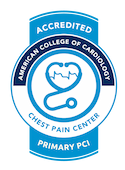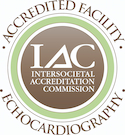Heart hospital in Dublin, Georgia
Cardiovascular disease is the leading cause of death in Georgia. However, you can take comfort in knowing that there is high-quality cardiovascular care available in Dublin-Laurens County, Georgia. The heart doctors at Fairview Park Hospital are dedicated to giving you the best care possible and are skilled at treating a range of heart and vascular diseases. We offer a team of experienced physicians and technologists as well as state-of-the-art technology, including a new, fully-equipped cardiac catheterization (cath) lab, to provide a full range of diagnostic and therapeutic services.
To find out more information about our heart care and services, call us at (478) 275-2000.
Recognition
Fairview Park Hospital is proud to be the region's only American College of Cardiology accredited Chest Pain Center with PCI. Our ECHO lab has also been accredited by the Intersocietal Accreditation Commission.


What is cardiovascular disease?
Cardiovascular diseases consist of diseases of the heart (cardio) and blood vessel (vascular) system, which includes arteries, capillaries and veins. Over time, the arteries that bring blood to the heart and brain can become blocked from a buildup of fat, cells and cholesterol. That buildup is known as plaque. It can cause a heart attack or stroke because of restricted blood flow to the brain from a blood clot (heart attack) or bleeding in the brain from a broken blood vessel (stroke).
Peripheral arterial disease (PAD)
PAD is the buildup of fatty deposits and plaque that block the flow of blood through arteries in the lower extremities. When there is a decrease in the blood supply to the legs, the most common symptom is pain or cramping when walking. If left untreated, this could lead to gangrene and the need for amputation.
Heart attack care
As the region's only Chest Pain Center with PCI accredited by the American College of Cardiology, we offer fast, effective heart attack care. When patients come to our emergency room (ER) with heart attack symptoms, our emergency cardiac specialists provide coordinated, timely diagnoses and treatments. We use advanced technology and offer a range of procedures to treat heart attacks.
Heart screening and imaging
We offer various techniques and non-invasive procedures to detect cardiovascular diseases, diagnose conditions and develop treatment plans. Some of our non-invasive heart screening and imaging services include:
- Echocardiography (ECHO)—ECHO exams use ultrasound technology to evaluate the heart's movement by creating images of the heart's valves and chambers.
- Electrocardiography (ECG or EKG)—Electrocardiograms record the heart's electrical signals to monitor heart health and detect heart conditions.
- Stress tests—These exams measure the heart's ability to respond to external stress by monitoring a patient during exercise.
- Telecardiology—This is a new wave of technology that allows a collaborative process among medical professionals to diagnose patients' conditions using a secure method of telecommunications.
What to expect during an electrocardiogram
A resting echocardiogram, also called ECG and EKG, does not require any special preparation. During an electrocardiogram, you can expect the following:
- You will lie on a bed while sticky patches, called electrodes, connected to wires are attached to your chest and shoulders. The electrodes will record your heart.
- A colorless gel will be applied to your chest.
- The echo transducer will be placed on top of the gel.
- The technologist will create recordings from different parts of your chest to obtain several views of the heart.
- You may be instructed to breathe slowly, hold your breath or move from your back to your side. This helps us obtain high-quality images.
- Images of your heart will be constantly viewed on the monitor. These images are also recorded on photographic paper and video.
- The recordings of the examination are reviewed by a physician before completion of the final report.
What to expect during a treadmill stress test
A treadmill stress test, also called a cardiac stress test, helps us determine how well your heart handles strain or exercise. The exam monitors your heart rate, breathing, blood pressure and how tired you feel under stress. Ultimately, the test shows if your blood supply is reduced in the arteries that supply the heart during physical activity.
During a treadmill stress test, you can expect the following:
- You will be hooked up to equipment that monitors your heart.
- The test will begin at a slow pace on the treadmill.
- After a period of time, the speed will increase.
- The treadmill will then be tilted to produce the effect of going up a small hill.
- You may be instructed to breathe into a tube for a couple of minutes.
- Your body will work hard during the test, requiring high levels of oxygen. This causes the heart to pump more blood. If needed, the test can be stopped at any time.
- After the test is completed, you will be asked to sit or lie down so we can check your heart rate and blood pressure.
Preparing for a treadmill thallium stress test
The treadmill thallium stress test shows how well blood flows to the heart muscle. It is often performed in conjunction with an exercise stress test on a treadmill or bicycle. This exam is performed to determine:
- A prognosis of a patient who has suffered from a heart attack
- The cause or causes of chest pain
- The effectiveness of a cardiac procedure
- The extent of damage from a coronary artery blockage
- The level of exercise that a patient can safely perform
During a treadmill thallium stress test, you can expect the following:
- The test will begin like a treadmill stress test does. You will be hooked up to equipment that monitors your heart. The test will begin at a slow pace on the treadmill. After a period of time, the speed will increase.
- When you reach your maximum level of exercise, a small amount of a radioactive substance called thallium will be injected into your bloodstream. The thallium mixes with blood in the bloodstream and the heart’s arteries and enters your heart muscle cells.
- You will lie down on a special table under a camera that can view the thallium as it captures images. If a part of the heart muscle does not receive a normal blood supply, less than a normal amount of thallium will be in those heart muscle cells.
- After the test, you will rest for two to three hours.
Our cardiovascular procedures
If we detect a heart or vascular condition during a non-invasive procedure, a more detailed, invasive procedure may be required. Some of the cardiovascular procedures we offer include:
- Angioplasty
- Bypass surgery
- Cardiac catheterization
- Heart transplant
- Stent placement
- Valve repair/replacement
Cardiac catheterization
Our new state-of-the-art cath lab offers the capability of digital X-ray imaging optimized for cardiovascular, angiographic and interventional imaging. This technology allows our cardiologists to view inside the body while performing diagnostic procedures and treating potential coronary artery blockages that could cause heart attacks or other serious cardiovascular damage.
What to expect during cardiac catheterization
Cardiac catheterization is a minimally invasive procedure used for both diagnostic and interventional purposes. During cardiac catheterization, you can expect the following:
- You will be put under mild anesthesia.
- Hollow plastic tubes, called catheters, will be inserted into your veins and/or the arteries in your neck, leg or arm.
- The catheters will be advanced to the right and/or left sides of the heart.
- Once the catheters are positioned in the various heart chambers or blood vessels, the pressure of the blood in various chambers of the heart is measured.
- Blood samples will be taken.
- A contrasting dye will be injected, allowing X-ray visualization.
Click here to tour our Cardiac Catheterization Lab
What to expect during a peripheral angioplasty
Peripheral angioplasty, also known as balloon angioplasty, is a procedure performed to treat PAD. During this procedure, you can expect the following:
- Your groin area will be treated with local anesthesia.
- Your cardiologist will insert a tiny, balloon-tipped catheter through a small puncture in the groin.
- The catheter is advanced to the affected artery and the site of the blockage.
- The balloon will be inflated to flatten the fatty deposits and widen the artery.
- A small metal tube or scaffold, called a stent, will be inserted to keep the artery open.
Cardiopulmonary rehabilitation services
We offer a cardiac and pulmonary rehabilitation program to help you regain strength and recover from heart events. With a supportive medical and allied health staff, our program incorporates education, physical therapy and exercise to help you reach your optimal level of well-being and self-sufficiency. Our skilled rehab team works together to provide one-on-one therapy to help you understand how the heart works, what it takes to keep it in good condition and help you develop and maintain a healthy heart.
What to expect from early outpatient cardiac rehab
After your heart or vascular surgery, our cardiac and pulmonary rehab team will work to ensure that you stay on the road to total heart health. Your rehab program will include education, therapy and monitored exercise. During exercise, we will track your heart’s response to ensure safety.
Your program may include:
- Aerobics, such as:
- Riding a stationary bike and specialized equipment
- Stair climbing
- Walking on a treadmill
- Cholesterol and weight management
- Diabetes management
- Smoking cessation
- Specialized diet
- Stress control
- Weight training
During your two-month rehab program, you will develop your independence in a monitored exercise setting to prepare you to move on to an independent exercise program in a wellness center.
Our cardiac and pulmonary rehab team
Some of the team members that make up our cardiac and pulmonary rehab program include:
- Dieticians
- Exercise specialists
- Nurses
- Occupational and physical therapists
- Pharmacists
- Physicians
A doctor’s referral is required to enter cardiac and pulmonary rehab. If you think you may be a candidate for cardiac rehabilitation, call us at (478) 274-3470.